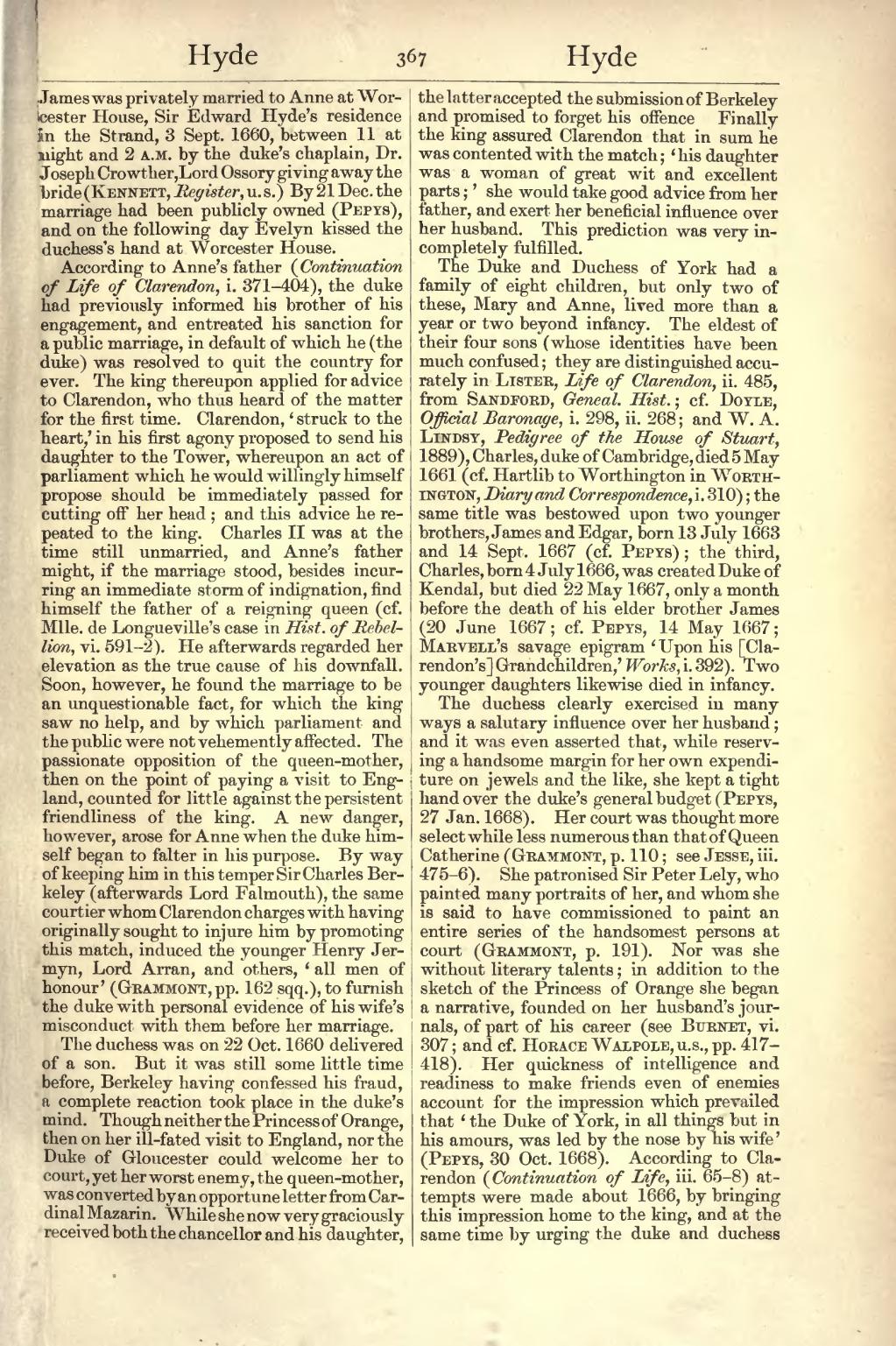James was privately married to Anne at Worcester House, Sir Edward Hyde's residence, in the Strand, 3 Sept. 1660, between 11 at night and 2 A.M. by the duke's chaplain, Dr. Joseph Crowther, Lord Ossory giving away the bride (Kennett, Register, u.s.) By 21 Dec. the marriage had been publicly owned (Pepys), and on the following day Evelyn kissed the duchess's hand at Worcester House.
According to Anne's father (Continuation of Life of Clarendon, i. 371-404), the duke had previously informed his brother of his engagement, and entreated his sanction for a public marriage, in default of which he (the duke) was resolved to quit the country for ever. The king thereupon applied for advice to Clarendon, who thus heard of the matter for the first time. Clarendon, struck to the heart,' in his first agony proposed to send his daughter to the Tower, whereupon an act of parliament which he would willingly himself propose should be immediately passed for cutting off her head; and this advice he repeated to the king. Charles II was at the time still unmarried, and Anne's father might, if the marriage stood, besides incurring an immediate storm of indignation, find himself the father of a reigning queen (cf. Mlle, de Longueville's case in Hist. of Rebellion, vi. 591-2). He afterwards regarded her elevation as the true cause of his downfall. Soon, however, he found the marriage to be an unquestionable fact, for which the king saw no help, and by which parliament and the public were not vehemently affected. The passionate opposition of the queen-mother, then on the point of paying a visit to England, counted for little against the persistent friendliness of the king. A new danger, however, arose for Anne when the duke himself began to falter in his purpose. By way of keeping him in this temper Sir Charles Berkeley (afterwards Lord Falmouth), the same courtier whom Clarendon charges with having originally sought to injure him by promoting this match, induced the younger Henry Jermyn, Lord Arran, and others, 'all men of honour' (Grammont, pp.162 sqq.), to furnish the duke with personal evidence of his wife's misconduct with them before her marriage, The duchess was on 22 Oct. 1660 delivered of a son. But it was still some little time before, Berkeley having confessed his fraud, a complete reaction took place in the duke's mind. Though neither the Princess of Orange, then on her ill-fated visit to England, nor the Duke of Gloucester could welcome her to court, yet her worst enemy, the queen-mother, was converted by an opportune letter from Cardinal Mazarin. While she now very graciously received both the chancellor and his daughter, the latter accepted the submission of Berkeley and promised to forget his offence Finally the king assured Clarendon that in sum he was contented with the match; 'his daughter was a woman of great wit and excellent parts;' she would take good advice from her father, and exert her beneficial influence over her husband. This prediction was very incompletely fulfilled.
The Duke and Duchess of York had a family of eight children, but only two of these, Mary and Anne, lived more than a year or two beyond infancy. The eldest of their four sons (whose identities have been much confused; they are distinguished accurately in Lister, Life of Clarendon, ii. 485, from Sandford, Geneal. Hist.; cf. Doyle, Official Baronage, i. 298, ii. 268; and W. A. Lindsy, Pedigree of the House of Stuart, 1889), Charles, duke of Cambridge, died 5 May 1661 (cf. Hartlib to Worthington in Worthington, Diary and Correspondence, i. 310); the same title was bestowed upon two younger brothers, James and Edgar, born 13 July 1663 and 14 Sept, 1667 (cf. Pepys); the third, Charles, born 4 July 1666, was created Duke of Kendal, but died 22 May 1667, only a month before the death of his elder brother James (20 June 1667; cf. Pepys, 14 May 1667; Marvell’s savage epigram `Upon his [Clarendon's] Grandchildren,' Works, i.392). Two younger daughters likewise died in infancy. The duchess clearly exercised in many ways a salutary influence over her husband; and it was even asserted that, while reserving a handsome margin for her own expenditure on jewels and the like, she kept a tight hand over the duke's general budget (Pepys, 27 Jan. 1668). Her court was thought more select while less numerous than that of Queen Catherine (Grammont, p.110; see Jesse, iii. 475-6). She patronised Sir Peter Lely, who painted many portraits of her, and whom she is said to have commissioned to paint an entire series of the handsomest persons at court (Grammont, p.191). Nor was she without literary talents; in addition to the sketch of the Princess of Orange she began a narrative, founded on her husband's journals, of part of his career (see Burnett, vi. 307; and cf. Horace Walpole,u.s., pp. 417-418). Her quickness of intelligence and readiness to make friends even of enemies account for the impression which prevailed that 'the Duke of York, in all things but in his amours, was led by the nose by his wife' (Pepys, 30 Oct. 1668). According to Clarendon (Continuation of Life, iii. 65-8) attempts were made about 1666, by bringing this impression home to the king, and at the same time by urging the duke and duchess
